2023 HYUNDAI IONIQ 6 brakes
[x] Cancel search: brakesPage 336 of 582

Driving Your Vehicle
6-48
Winter Driving
The severe weather conditions of winter
quickly wear out tires and cause other
problems. To minimize winter driving
problems, you should take the following
suggestions:
Snow or Icy Conditions
You need to keep sufficient distance
between your vehicle and the vehicle in
front of you.
Apply the brakes gently. Speeding, rapid
acceleration, sudden brake applications,
and sharp turns are potentially very
hazardous practices. Sudden brake
applications on snowy or icy roads may
cause the vehicle to skid.
To drive your vehicle in deep snow, it may
be necessary to install tire chains on your
tires.
Always carry emergency equipment.
Some of the items you may want to carry
include tire chains, tow straps or chains, a
flashlight, emergency flares, sand, a
shovel, jumper cables, a window scraper,
gloves, ground cloth, coveralls, a blanket,
etc.
Snow tires
WARNING Snow tires should be equivalent in size
and type to the vehicle’s standard tires.
Otherwise, the safety and handling of
your vehicle may be adversely affected.
If you mount snow tires on your vehicle,
make sure to use radial tires of the same
size and load range as the original tires.
Mount snow tires on all four wheels to
balance your vehicle’s handling in all
weather conditions. The traction
provided by snow tires on dry roads may
not be as high as your vehicle’s original
equipment tires. Check with the tire dealer for maximum speed
recommendations.
Information Do not install studded tires without first
checking local and municipal regulations for
possible restrictions against their use.
Summer tires
• Summer tires are used to maximize the
driving performance on dry roads.
• If the temperature is below 45 °F (7 °C) or you are driving on snowy or icy
roads, the summer tires lose their brake
performance and traction as the tire
grip weakens significantly.
• If the temperature is below 45 °F (7 °C) or you are driving on snowy or icy
roads, mount snow tires or all-season
tires of the same size with your
vehicle’s standard tire for safe driving.
Both snow and all-season tires have
M+S markings.
• When using the M+S tires, use tires with the same tread produced by the same
manufacturer for safe driving.
• When driving with the M+S tires with the lower maximum allowable speed
than that of the vehicle’s standard
summer tire, be careful not to exceed
the speed allowed for the M+S tires.
Hyundai_CE_en_US.book Page 48
Page 339 of 582

6
6-51
Check battery and cables
Winter temperatures affect battery
performance. Inspect the battery and
cables, as specified in chapter 9. The
battery charging level can be inspected
by an authorized HYUNDAI dealer or in a
service station.
To prevent locks from freezing
Spray approved de-icing fluid or glycerin
into key holes. When a lock opening is
already covered with ice, spray approved
de-icing fluid over the ice to remove it.
When an internal part of a lock freezes, try
to thaw it with a heated key. Carefully use
the heated key to avoid an injury.
Use approved window washer anti-freeze
solution
Add authorized window washer
anti-freeze solution, as specified on the
window washer container. Window
washer anti-freeze solution is available
from an authorized HYUNDAI dealer, and
most vehicle accessory outlets. Do not
use coolant or other types of anti-freeze
solution, to prevent any damage to the
vehicle paint.
Do not let your parking brake freeze
Under some conditions, your parking
brake may freeze in the engaged position.
This is most likely to happen when there is
an accumulation of snow or ice around or
near the rear brakes or the brakes are wet.
When there is the risk that your parking
brake may freeze: temporarily apply the
parking brake with the gear in P (Park),
then block the rear wheels, and then
release the parking brake.Do not let ice and snow accumulate
underneath
Under some conditions, snow and ice
may build up under the fenders and
interfere with the steering. When driving
in such conditions during the severe
winter, check underneath the vehicle on a
regular basis, to make sure that the front
wheels and the steering components are
not blocked.
Carry emergency equipment
In accordance with weather conditions,
carry appropriate emergency equipment,
while driving. Some of the items you may
want to carry include tire chains, tow
straps or chains, flashlight, emergency
flares, sand, shovel, jumper cables,
window scraper, gloves, ground cloth,
coveralls, blanket, etc.
Do not place objects or materials in the
motor compartment
Putting objects or materials in the motor
compartment may cause a motor failure.
Such damage is not be covered by the
manufacturer’s warranty.
Hyundai_CE_en_US.book Page 51
Page 377 of 582
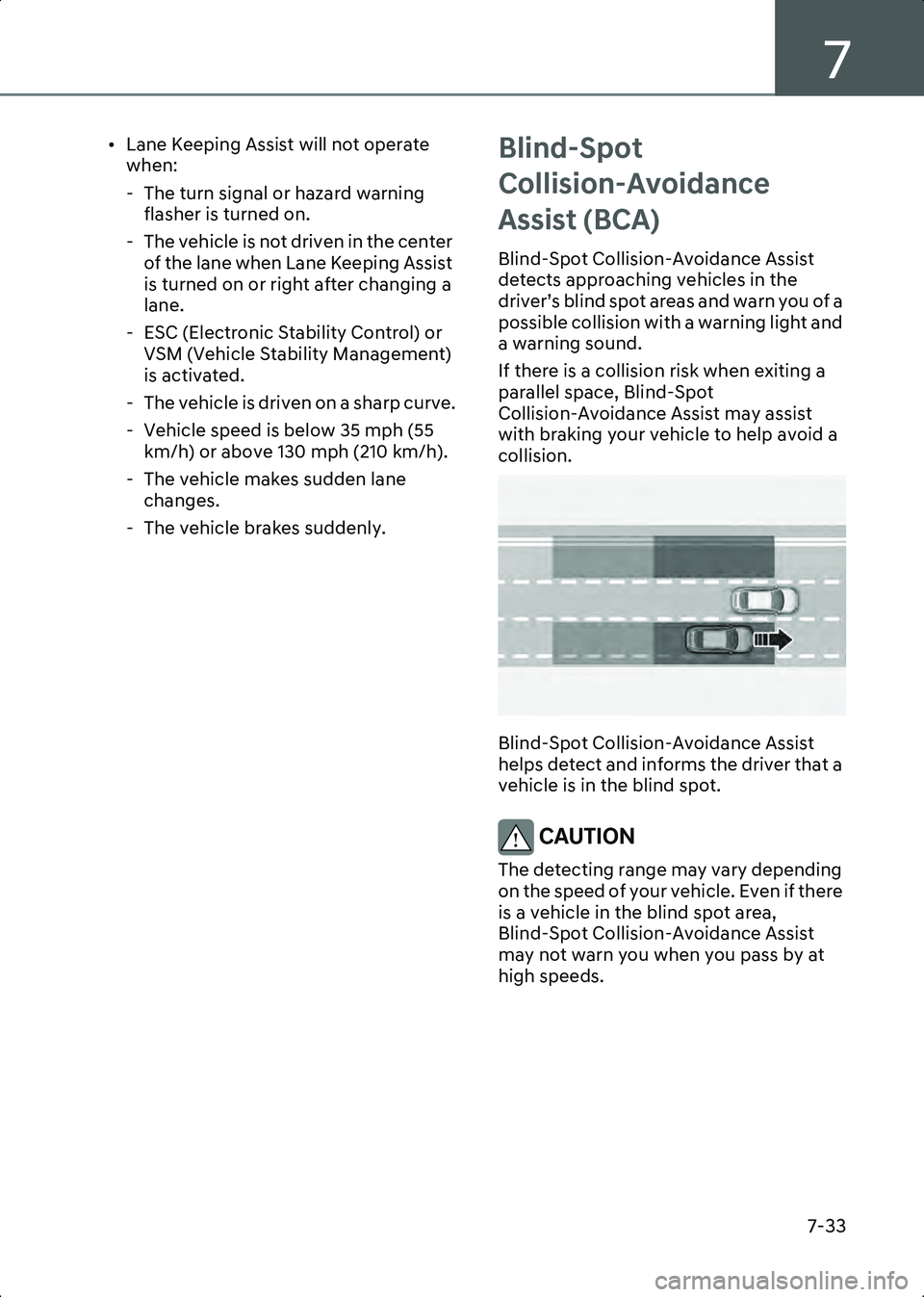
7
7-33
• Lane Keeping Assist will not operate when:
- The turn signal or hazard warning flasher is turned on.
- The vehicle is not driven in the center of the lane when Lane Keeping Assist
is turned on or right after changing a
lane.
- ESC (Electronic Stability Control) or VSM (Vehicle Stability Management)
is activated.
- The vehicle is driven on a sharp curve.
- Vehicle speed is below 35 mph (55 km/h) or above 130 mph (210 km/h).
- The vehicle makes sudden lane changes.
- The vehicle brakes suddenly.
Blind-Spot
Collision-Avoidance
Assist (BCA)
Blind-Spot Collision-Avoidance Assist
detects approaching vehicles in the
driver’s blind spot areas and warn you of a
possible collision with a warning light and
a warning sound.
If there is a collision risk when exiting a
parallel space, Blind-Spot
Collision-Avoidance Assist may assist
with braking your vehicle to help avoid a
collision.
B7001301
Blind-Spot Collision-Avoidance Assist
helps detect and informs the driver that a
vehicle is in the blind spot.
CAUTION The detecting range may vary depending
on the speed of your vehicle. Even if there
is a vehicle in the blind spot area,
Blind-Spot Collision-Avoidance Assist
may not warn you when you pass by at
high speeds.
Hyundai_CE_en_US.book Page 33
Page 453 of 582
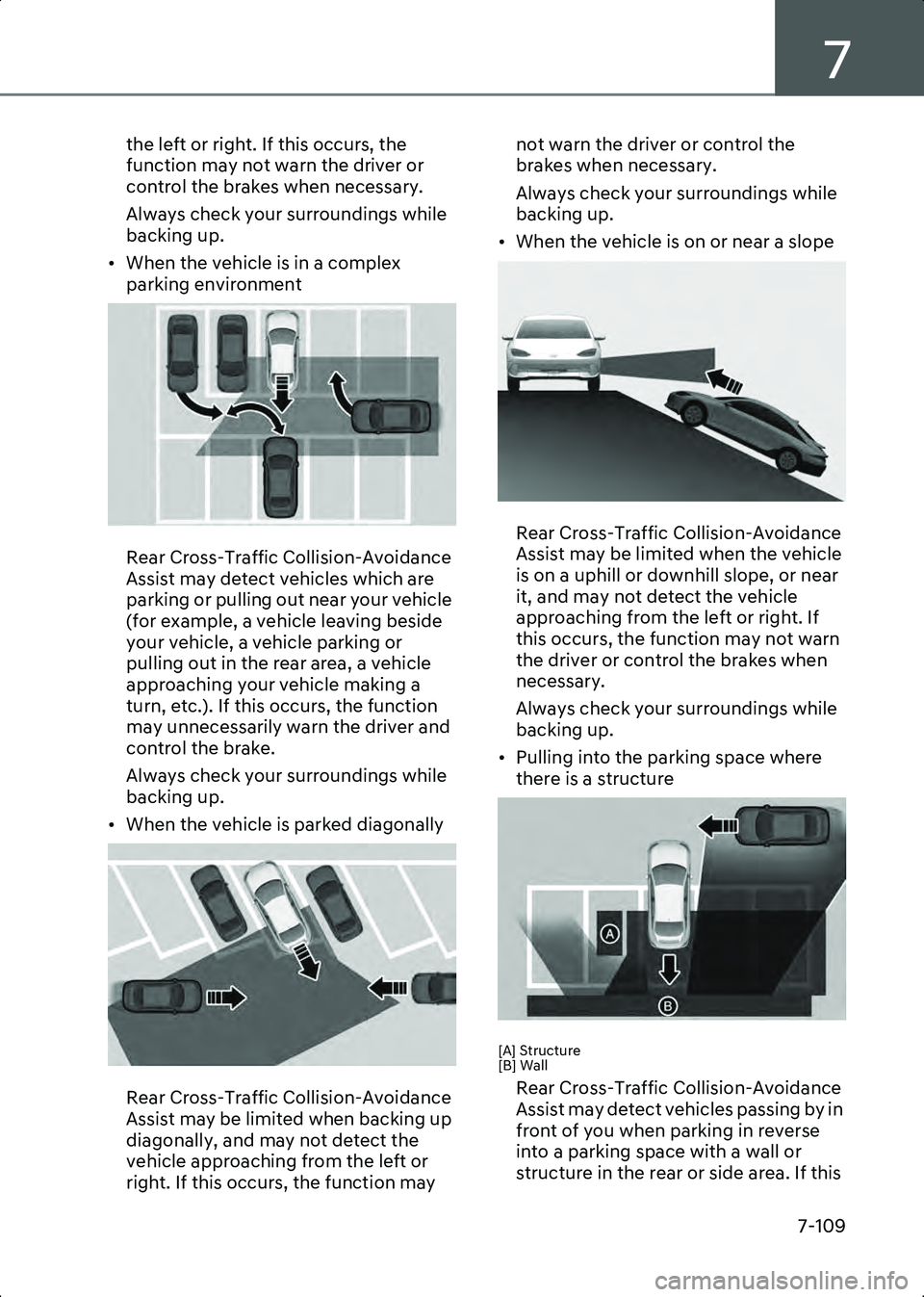
7
7-109
the left or right. If this occurs, the
function may not warn the driver or
control the brakes when necessary.
Always check your surroundings while
backing up.
• When the vehicle is in a complex parking environment
B7006905
Rear Cross-Traffic Collision-Avoidance
Assist may detect vehicles which are
parking or pulling out near your vehicle
(for example, a vehicle leaving beside
your vehicle, a vehicle parking or
pulling out in the rear area, a vehicle
approaching your vehicle making a
turn, etc.). If this occurs, the function
may unnecessarily warn the driver and
control the brake.
Always check your surroundings while
backing up.
• When the vehicle is parked diagonally
B7006906
Rear Cross-Traffic Collision-Avoidance
Assist may be limited when backing up
diagonally, and may not detect the
vehicle approaching from the left or
right. If this occurs, the function may not warn the driver or control the
brakes when necessary.
Always check your surroundings while
backing up.
• When the vehicle is on or near a slope
B7006907
Rear Cross-Traffic Collision-Avoidance
Assist may be limited when the vehicle
is on a uphill or downhill slope, or near
it, and may not detect the vehicle
approaching from the left or right. If
this occurs, the function may not warn
the driver or control the brakes when
necessary.
Always check your surroundings while
backing up.
• Pulling into the parking space where there is a structure
B7006908
[A] Structure
[B] Wall
Rear Cross-Traffic Collision-Avoidance
Assist may detect vehicles passing by in
front of you when parking in reverse
into a parking space with a wall or
structure in the rear or side area. If this
Hyundai_CE_en_US.book Page 109
Page 468 of 582
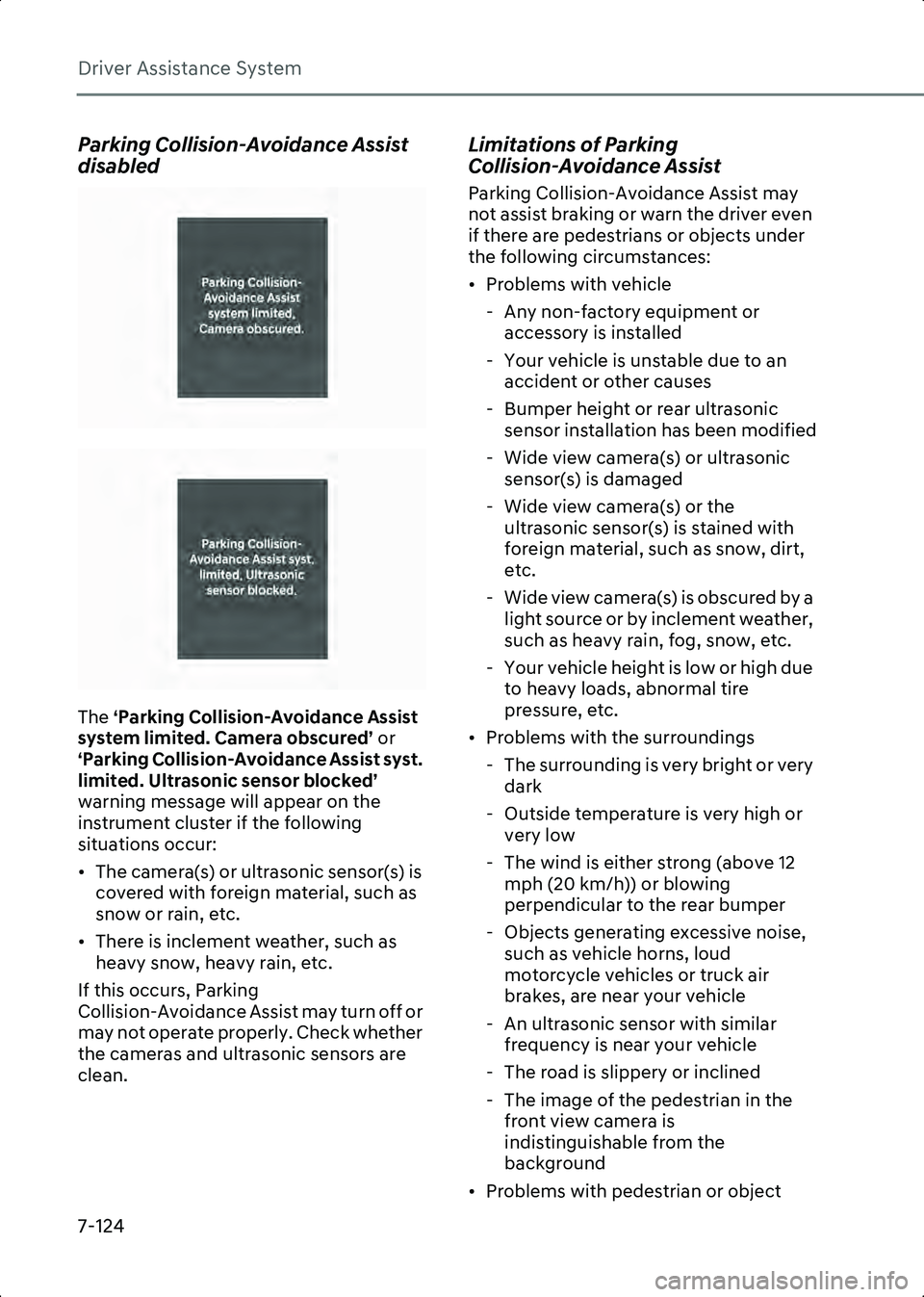
Driver Assistance System
7-124
Parking Collision-Avoidance Assist
disabled
B7008102
B7008103
The ‘Parking Collision-Avoidance Assist
system limited. Camera obscured’ or
‘Parking Collision-Avoidance Assist syst.
limited. Ultrasonic sensor blocked’
warning message will appear on the
instrument cluster if the following
situations occur:
• The camera(s) or ultrasonic sensor(s) is covered with foreign material, such as
snow or rain, etc.
• There is inclement weather, such as heavy snow, heavy rain, etc.
If this occurs, Parking
Collision-Avoidance Assist may turn off or
may not operate properly. Check whether
the cameras and ultrasonic sensors are
clean.
Limitations of Parking
Collision-Avoidance Assist
Parking Collision-Avoidance Assist may
not assist braking or warn the driver even
if there are pedestrians or objects under
the following circumstances:
• Problems with vehicle - Any non-factory equipment or accessory is installed
- Your vehicle is unstable due to an accident or other causes
- Bumper height or rear ultrasonic sensor installation has been modified
- Wide view camera(s) or ultrasonic sensor(s) is damaged
- Wide view camera(s) or the ultrasonic sensor(s) is stained with
foreign material, such as snow, dirt,
etc.
- Wide view camera(s) is obscured by a light source or by inclement weather,
such as heavy rain, fog, snow, etc.
- Your vehicle height is low or high due to heavy loads, abnormal tire
pressure, etc.
• Problems with the surroundings - The surrounding is very bright or very dark
- Outside temperature is very high or very low
- The wind is either strong (above 12 mph (20 km/h)) or blowing
perpendicular to the rear bumper
- Objects generating excessive noise, such as vehicle horns, loud
motorcycle vehicles or truck air
brakes, are near your vehicle
- An ultrasonic sensor with similar frequency is near your vehicle
- The road is slippery or inclined
- The image of the pedestrian in the front view camera is
indistinguishable from the
background
• Problems with pedestrian or object
Hyundai_CE_en_US.book Page 124
Page 498 of 582
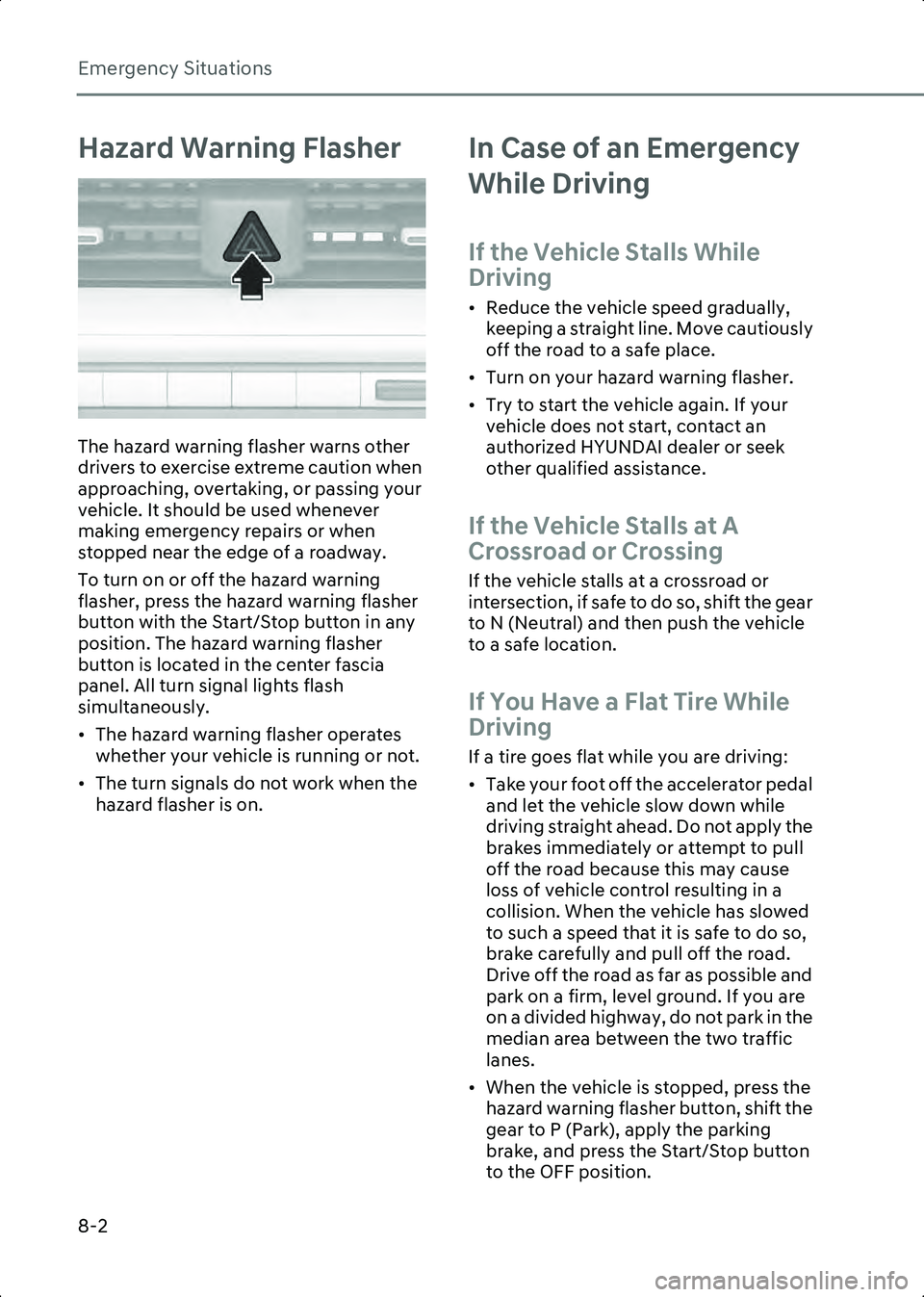
Emergency Situations
8-2
Hazard Warning Flasher
B8000201
The hazard warning flasher warns other
drivers to exercise extreme caution when
approaching, overtaking, or passing your
vehicle. It should be used whenever
making emergency repairs or when
stopped near the edge of a roadway.
To turn on or off the hazard warning
flasher, press the hazard warning flasher
button with the Start/Stop button in any
position. The hazard warning flasher
button is located in the center fascia
panel. All turn signal lights flash
simultaneously.
• The hazard warning flasher operates whether your vehicle is running or not.
• The turn signals do not work when the hazard flasher is on.
In Case of an Emergency
While Driving
If the Vehicle Stalls While
Driving
• Reduce the vehicle speed gradually, keeping a straight line. Move cautiously
off the road to a safe place.
• Turn on your hazard warning flasher.
• Try to start the vehicle again. If your vehicle does not start, contact an
authorized HYUNDAI dealer or seek
other qualified assistance.
If the Vehicle Stalls at A
Crossroad or Crossing
If the vehicle stalls at a crossroad or
intersection, if safe to do so, shift the gear
to N (Neutral) and then push the vehicle
to a safe location.
If You Have a Flat Tire While
Driving
If a tire goes flat while you are driving:
• Take your foot off the accelerator pedal and let the vehicle slow down while
driving straight ahead. Do not apply the
brakes immediately or attempt to pull
off the road because this may cause
loss of vehicle control resulting in a
collision. When the vehicle has slowed
to such a speed that it is safe to do so,
brake carefully and pull off the road.
Drive off the road as far as possible and
park on a firm, level ground. If you are
on a divided highway, do not park in the
median area between the two traffic
lanes.
• When the vehicle is stopped, press the hazard warning flasher button, shift the
gear to P (Park), apply the parking
brake, and press the Start/Stop button
to the OFF position.
Hyundai_CE_en_US.book Page 2
Page 507 of 582
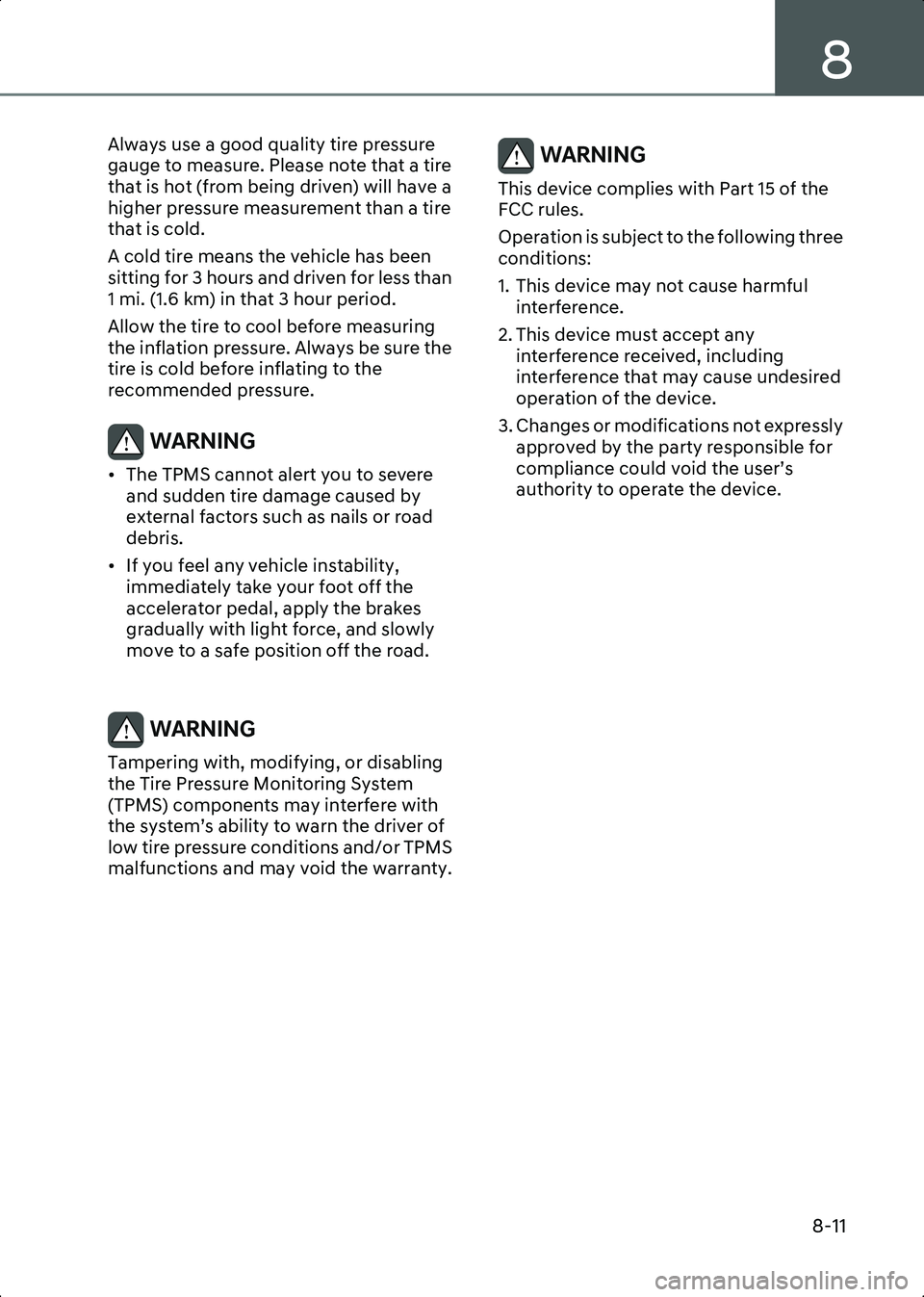
8
8-11
Always use a good quality tire pressure
gauge to measure. Please note that a tire
that is hot (from being driven) will have a
higher pressure measurement than a tire
that is cold.
A cold tire means the vehicle has been
sitting for 3 hours and driven for less than
1 mi. (1.6 km) in that 3 hour period.
Allow the tire to cool before measuring
the inflation pressure. Always be sure the
tire is cold before inflating to the
recommended pressure.
WARNING • The TPMS cannot alert you to severe and sudden tire damage caused by
external factors such as nails or road
debris.
• If you feel any vehicle instability, immediately take your foot off the
accelerator pedal, apply the brakes
gradually with light force, and slowly
move to a safe position off the road.
WARNING Tampering with, modifying, or disabling
the Tire Pressure Monitoring System
(TPMS) components may interfere with
the system’s ability to warn the driver of
low tire pressure conditions and/or TPMS
malfunctions and may void the warranty.
WARNING This device complies with Part 15 of the
FCC rules.
Operation is subject to the following three
conditions:
1. This device may not cause harmful interference.
2. This device must accept any interference received, including
interference that may cause undesired
operation of the device.
3. Changes or modifications not expressly approved by the party responsible for
compliance could void the user’s
authority to operate the device.
Hyundai_CE_en_US.book Page 11
Page 524 of 582

Maintenance
9-8
Normal Maintenance Schedule
The following maintenance services must be performed to ensure good vehicle
performance.
Keep receipts for all vehicle services to protect your warranty. Where both mileage and
time are shown, the frequency of service is determined by whichever occurs first.
I: Inspect and if necessary, adjust, correct, clean or replace.
R: Replace or change.
MAINTENANCE INTERVALS
MAINTENANCE ITEM
Months1224364860728496108120132144156
Miles
×1,00081624324048566472808896104
Km
×1,00013263952657891104117130143156169
Cooling system
I I I I I I I I I I I I I
12 V auxiliary battery
condition
Brake lines, hoses, and
connections
Disc brakes and pads
Brake pedal
Steering gear rack,
linkage, and boots
Air conditioning
compressor, air
conditioner refrigerant
and performance
Hyundai_CE_en_US.book Page 8